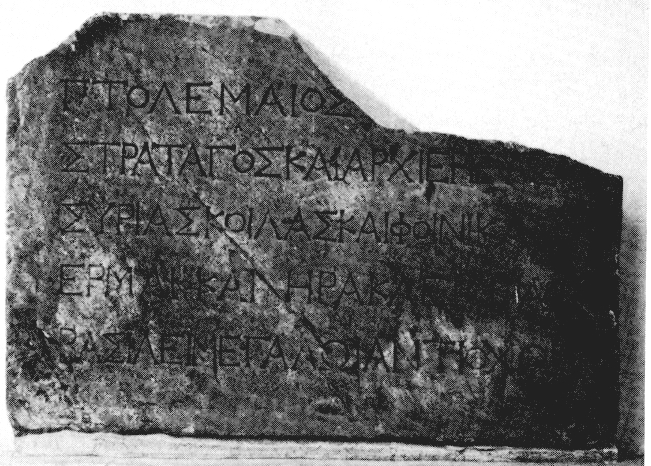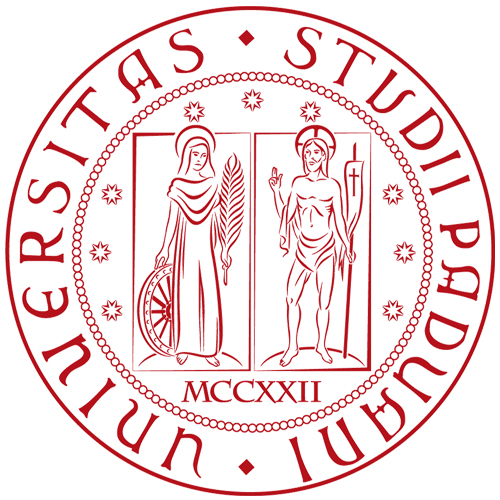
PHRC007 : Dedication by the official Ptolemaios to Hermes, Herakles, Antiochos III, Soloi - Kilikia (197 BC) Dedication
Permanent ID http://s.phrc.it/phrc007
Images:
Photo 1: Photo 1: photo of the stone, from Amandry et al. 1972, p. 110, fig. 11

Text constituted from: Radet - Paris 1890, p. 587-589 (followed by OGIS 230), with wrong date (218 BC).
Other editions: P. Amandry et al. 1972, p. 109-110, no. 15, with wrong integration of the father's name at the end of line 1 (this fragment had been lost at one point between the editio princeps and the publication of the EFA catalogue).
See also: Radet 1893, p. 61-62 (with the correct date, 197 BC); RIG 1229; Hollaux 1942, p. 160-161 and n. 6 (discussing the date 197 BC); Piejko 1991; Ma 2002, p. 82-83, 321-323, no. 21 (English trans.).
Images: Amandry et al. 1972, p. 110, fig. 11.
Further bibliography: Gera 1987, p. 63–73; Jones - Habicht 1989, p. 335-346; Heinrichs 2018, p. 272-311.
Online record: Trismegistos
The author of the dedication is a well-known official of Antiochos III: Ptolemaios son of Thraseas (Gera 1987; Jones – Habicht 1989, p. 335-346; Heinrichs 2018). The descendant of an Aspendian family of Ptolemaic officials (cf. PHRC010), Ptolemaios deserted to Antiochos after serving the Ptolemaic army during the 4th Syrian War ( Polybius, V.65.3). His passage to the Seleucid side was rewarded with the concession (or confirmation) of private estates at Skythopolis (Beit She'an, area of Hefzibah; SEG XXIX 1613, 199/8 BC). His dedication in Soloi, Kilikia, has been convincingly put in relation with the beginning of Antiochos’ campaign in Asia Minor (spring 197 BC).
The dedication made by Ptolemaios was addressed to the gods Hermes and Herakles, together with the king Antiochos III, following a common pattern of cultic honours in Hellenistic gymnasia. However, unlike other similar documents, which stemmed from the initiative of members of the local gymnasium, Ptolemaios’ dedication sheds light on the activity of a foreigner: a royal official who, as we may infer, was acting on a personal initiative, in the period immediately after Antiochos’ conquest of Soloi, when new links had to be established between the civic elite and the king. Ptolemaios’s initiative would serve this strategic purpose, as the euergetic act in the gymnasium stemmed from an official of the king, while at the same time manifesting the personal loyalty of the governor and high-priest of Koile Syria and Phoenicia toward his patron.
Comparison with similar dedications in gymnasia allows to point at a small statue as a plausible object with which this dedicatory text was associated. This hypothesis is coherent with the suggestion by Ma 2002, p. 322, that the Soloi slab might have been sawn in modern times from the block to which it originally belonged, in order to allow transport and sale at Mersin.
The name of the recipient Antiochos is accompanied by the solemn denomination “Great King”, drawn from Achaemenid precedents and already used by Ptolemy III in the report of his military exploits in the East after the Laodikean War ( OGIS 54, line 1). The link between this title and the military dominion over Asia has been stressed by Ma 2002, p. 73, 275-276: the documentation proves this title was taken by Antiochos only after his conquest of Koile Syria in the IV Syrian War (200 BC).



